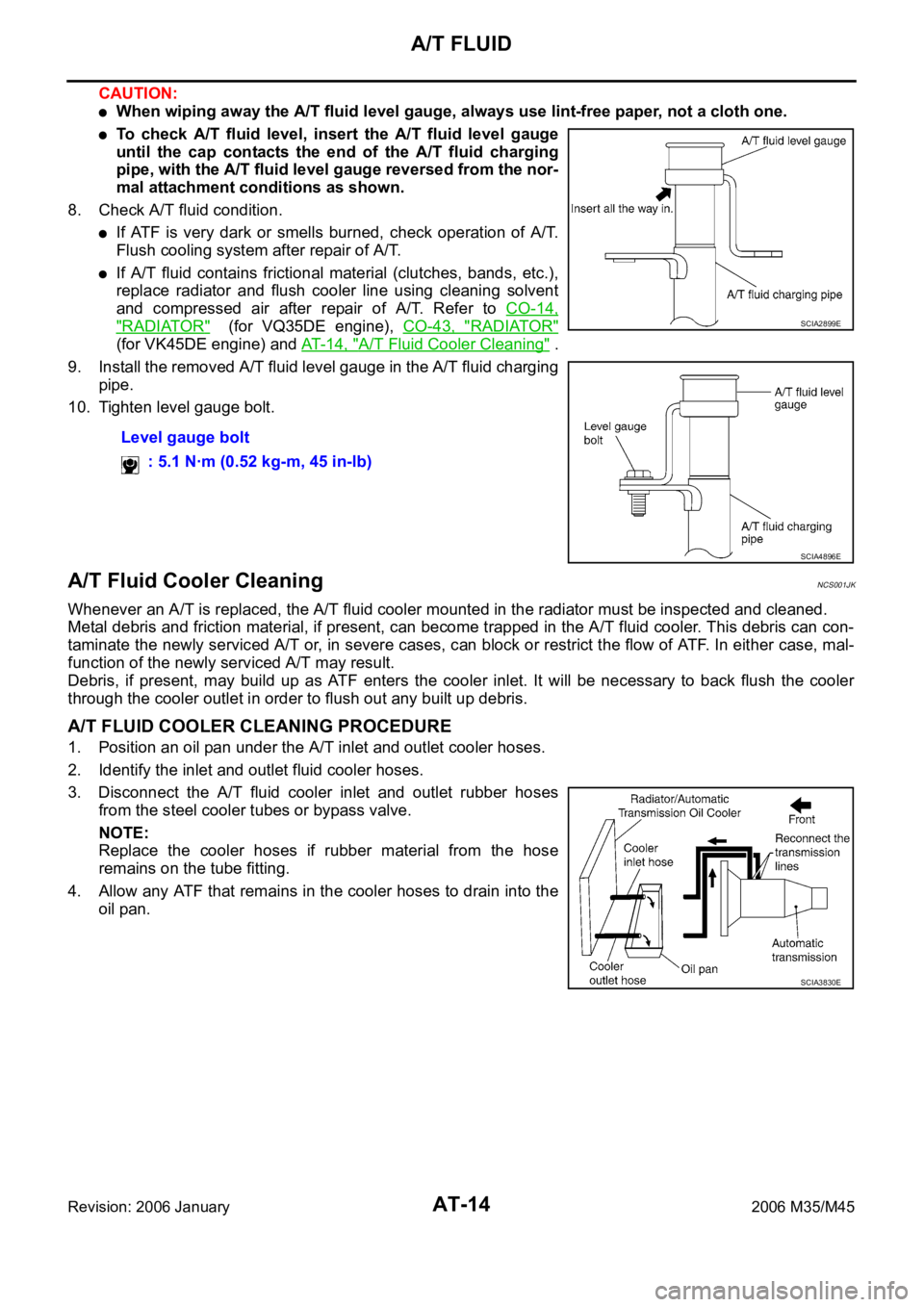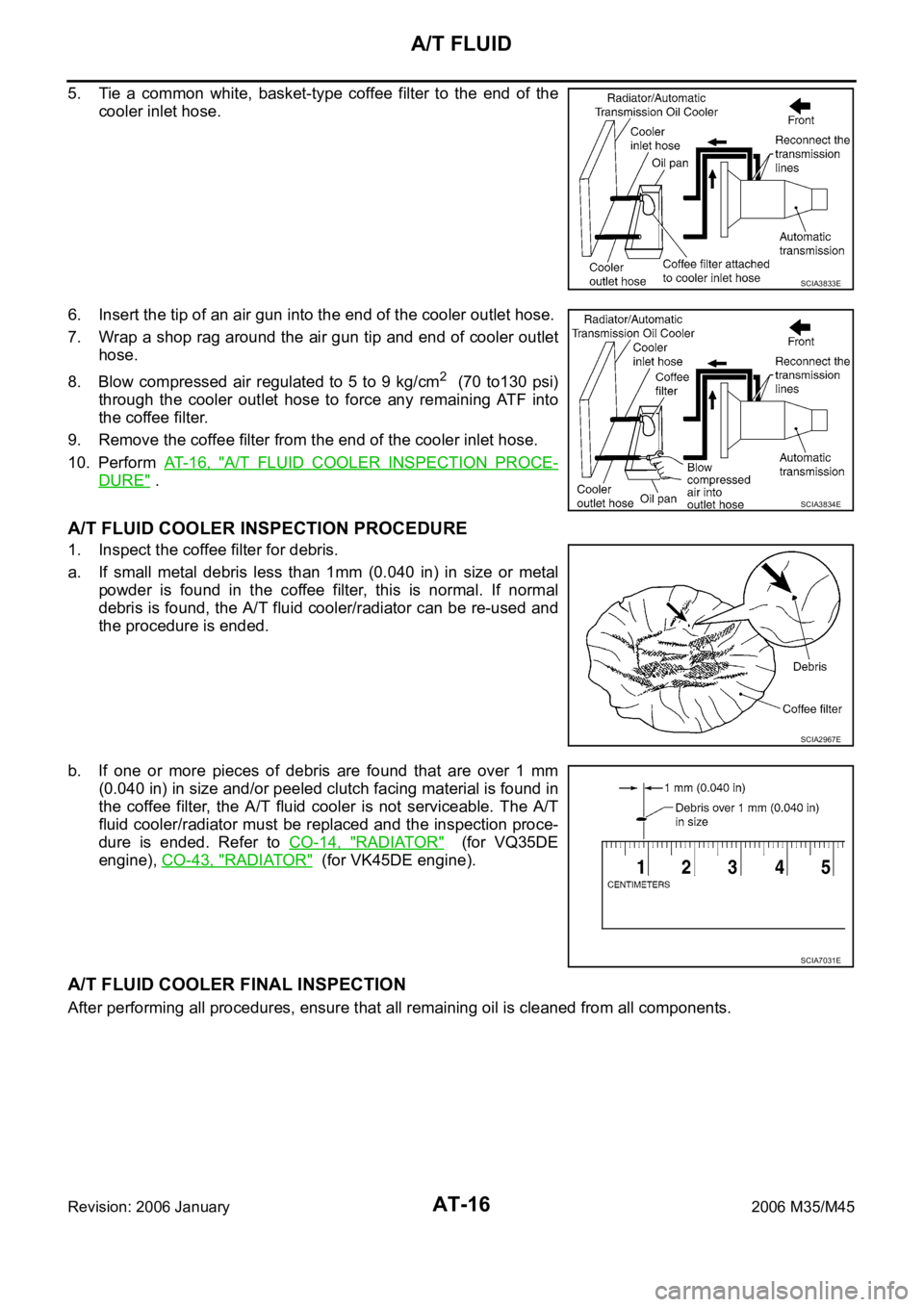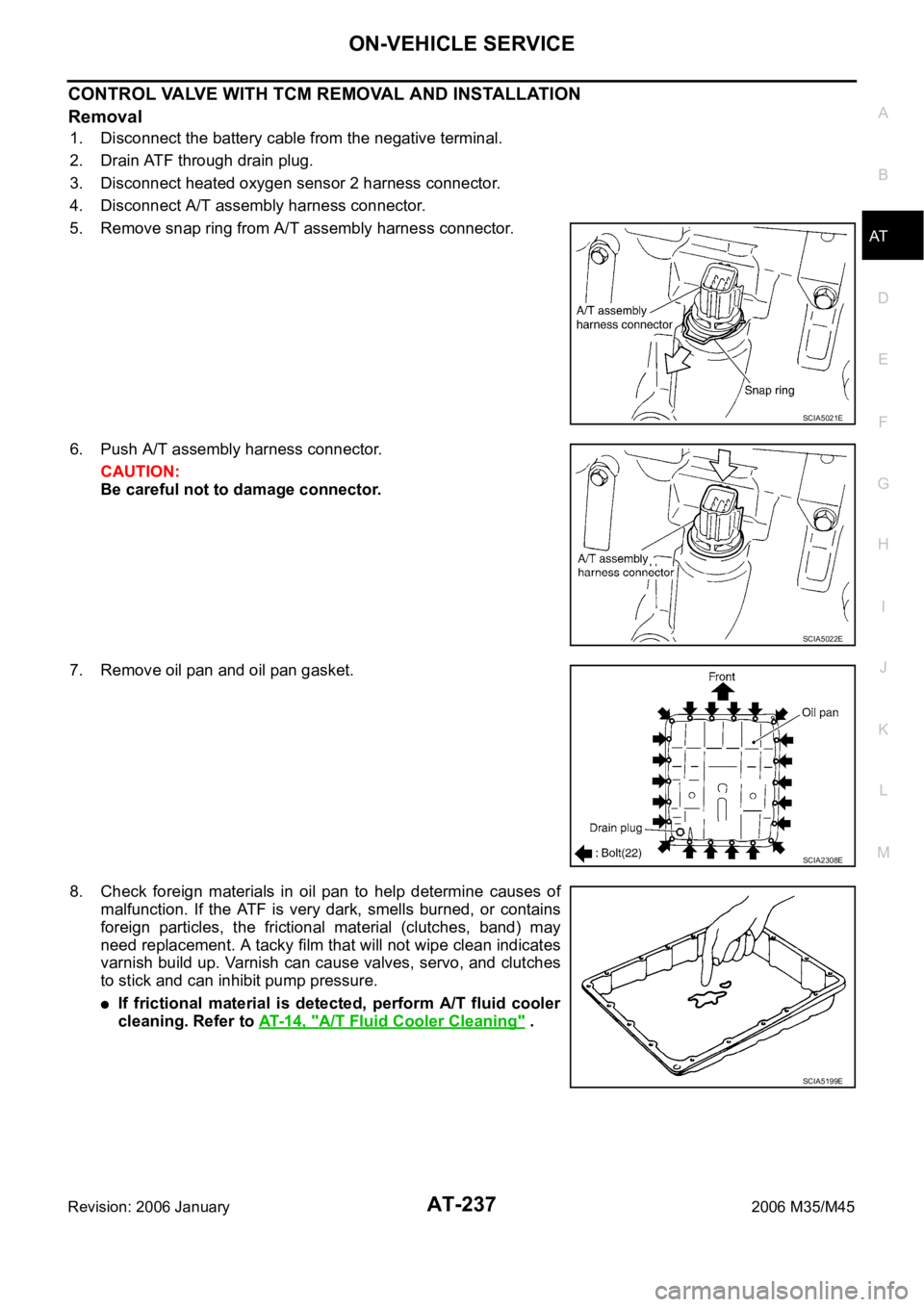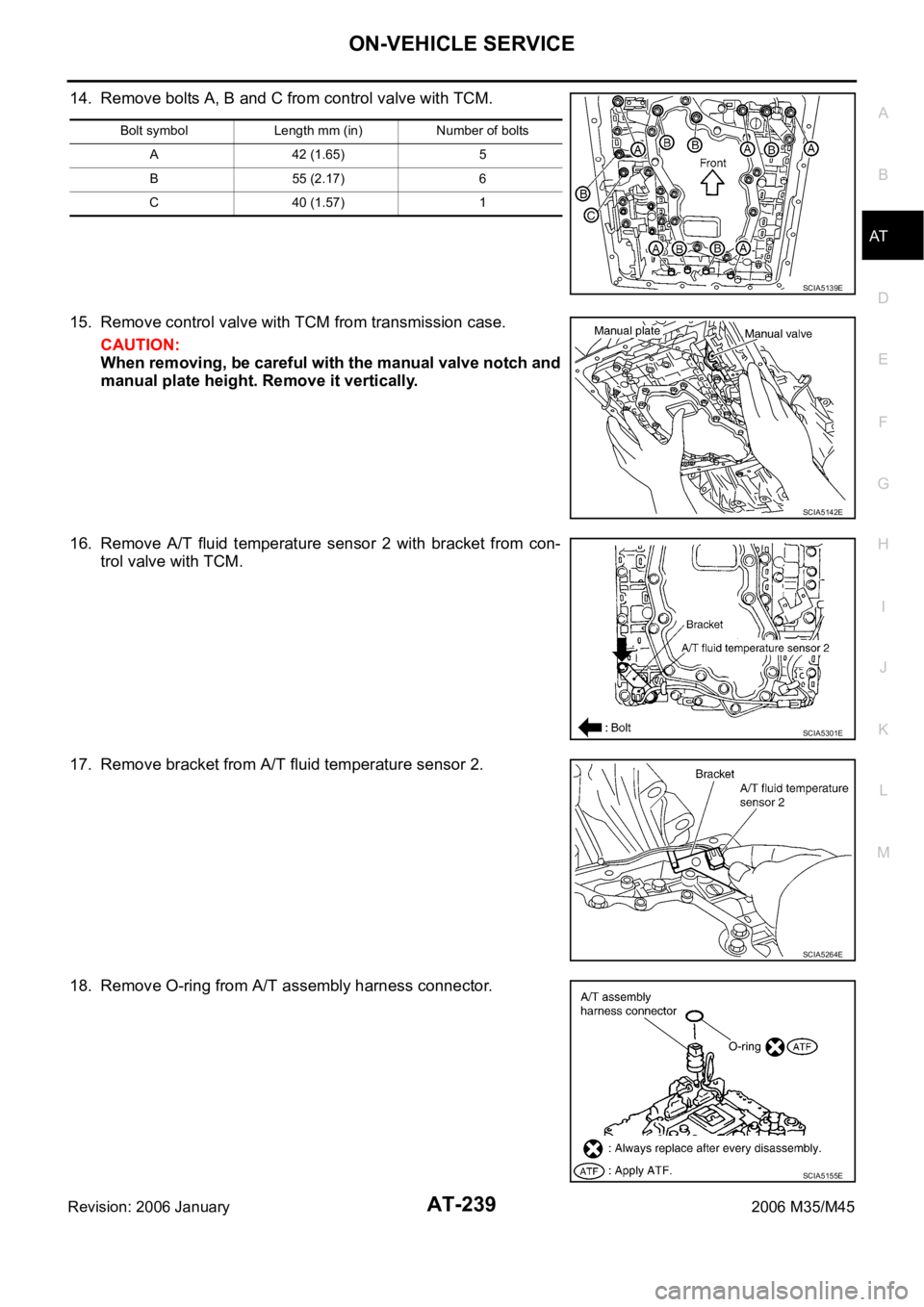service INFINITI M35 2006 Factory User Guide
[x] Cancel search | Manufacturer: INFINITI, Model Year: 2006, Model line: M35, Model: INFINITI M35 2006Pages: 5621, PDF Size: 65.56 MB
Page 90 of 5621

PREPARATION
AT-11
D
E
F
G
H
I
J
K
L
MA
B
AT
Revision: 2006 January2006 M35/M45
Commercial Service ToolsNCS001JH
To o l n a m eDescription
Power toolLoosening bolts and nuts
Drift
a: 22 mm (0.87 in) dia.Installing manual shaft oil seals
Drift
a: 64 mm (2.52 in) dia.Installing rear oil seal (AWD models)
PBIC0190E
NT083
SCIA5338E
Page 93 of 5621

AT-14
A/T FLUID
Revision: 2006 January2006 M35/M45
CAUTION:
When wiping away the A/T fluid level gauge, always use lint-free paper, not a cloth one.
To check A/T fluid level, insert the A/T fluid level gauge
until the cap contacts the end of the A/T fluid charging
pipe, with the A/T fluid level gauge reversed from the nor-
mal attachment conditions as shown.
8. Check A/T fluid condition.
If ATF is very dark or smells burned, check operation of A/T.
Flush cooling system after repair of A/T.
If A/T fluid contains frictional material (clutches, bands, etc.),
replace radiator and flush cooler line using cleaning solvent
and compressed air after repair of A/T. Refer to CO-14,
"RADIATOR" (for VQ35DE engine), CO-43, "RADIATOR"
(for VK45DE engine) and AT- 1 4 , "A/T Fluid Cooler Cleaning" .
9. Install the removed A/T fluid level gauge in the A/T fluid charging
pipe.
10. Tighten level gauge bolt.
A/T Fluid Cooler CleaningNCS001JK
Whenever an A/T is replaced, the A/T fluid cooler mounted in the radiator must be inspected and cleaned.
Metal debris and friction material, if present, can become trapped in the A/T fluid cooler. This debris can con-
taminate the newly serviced A/T or, in severe cases, can block or restrict the flow of ATF. In either case, mal-
function of the newly serviced A/T may result.
Debris, if present, may build up as ATF enters the cooler inlet. It will be necessary to back flush the cooler
through the cooler outlet in order to flush out any built up debris.
A/T FLUID COOLER CLEANING PROCEDURE
1. Position an oil pan under the A/T inlet and outlet cooler hoses.
2. Identify the inlet and outlet fluid cooler hoses.
3. Disconnect the A/T fluid cooler inlet and outlet rubber hoses
from the steel cooler tubes or bypass valve.
NOTE:
Replace the cooler hoses if rubber material from the hose
remains on the tube fitting.
4. Allow any ATF that remains in the cooler hoses to drain into the
oil pan.Level gauge bolt
: 5.1 Nꞏm (0.52 kg-m, 45 in-lb)
SCIA2899E
SCIA4896E
SCIA3830E
Page 95 of 5621

AT-16
A/T FLUID
Revision: 2006 January2006 M35/M45
5. Tie a common white, basket-type coffee filter to the end of the
cooler inlet hose.
6. Insert the tip of an air gun into the end of the cooler outlet hose.
7. Wrap a shop rag around the air gun tip and end of cooler outlet
hose.
8. Blow compressed air regulated to 5 to 9 kg/cm
2 (70 to130 psi)
through the cooler outlet hose to force any remaining ATF into
the coffee filter.
9. Remove the coffee filter from the end of the cooler inlet hose.
10. Perform AT- 1 6 , "
A/T FLUID COOLER INSPECTION PROCE-
DURE" .
A/T FLUID COOLER INSPECTION PROCEDURE
1. Inspect the coffee filter for debris.
a. If small metal debris less than 1mm (0.040 in) in size or metal
powder is found in the coffee filter, this is normal. If normal
debris is found, the A/T fluid cooler/radiator can be re-used and
the procedure is ended.
b. If one or more pieces of debris are found that are over 1 mm
(0.040 in) in size and/or peeled clutch facing material is found in
the coffee filter, the A/T fluid cooler is not serviceable. The A/T
fluid cooler/radiator must be replaced and the inspection proce-
dure is ended. Refer to CO-14, "
RADIATOR" (for VQ35DE
engine), CO-43, "
RADIATOR" (for VK45DE engine).
A/T FLUID COOLER FINAL INSPECTION
After performing all procedures, ensure that all remaining oil is cleaned from all components.
SCIA3833E
SCIA3834E
SCIA2967E
SCIA7031E
Page 125 of 5621

AT-46
TROUBLE DIAGNOSIS
Revision: 2006 January2006 M35/M45
How to Perform Trouble Diagnosis for Quick and Accurate RepairNCS001K4
INTRODUCTION
The TCM receives a signal from the vehicle speed sensor, accelera-
tor pedal position sensor (throttle position sensor) or PNP switch and
provides shift control or lock-up control via A/T solenoid valves.
The TCM also communicates with the ECM by means of a signal
sent from sensing elements used with the OBD-related parts of the
A/T system for malfunction-diagnostic purposes. The TCM is capa-
ble of diagnosing malfunctioning parts while the ECM can store mal-
functions in its memory.
Input and output signals must always be correct and stable in the
operation of the A/T system. The A/T system must be in good oper-
ating condition and be free of valve seizure, solenoid valve malfunc-
tion, etc.
It is much more difficult to diagnose a error that occurs intermittently
rather than continuously. Most intermittent errors are caused by poor
electric connections or improper wiring. In this case, careful check-
ing of suspected circuits may help prevent the replacement of good
parts.
A visual check only may not find the cause of the errors. A road test
with CONSULT-II (or GST) or a circuit tester connected should be
performed. Follow the AT- 4 7 , "
WORK FLOW" .
Before undertaking actual checks, take a few minutes to talk with a
customer who approaches with a driveability complaint. The cus-
tomer can supply good information about such errors, especially
intermittent ones. Find out what symptoms are present and under
what conditions they occur. A “DIAGNOSTIC WORKSHEET” as
shown on the example (Refer to AT- 4 8
) should be used.
Start your diagnosis by looking for “conventional” errors first. This will
help troubleshoot driveability errors on an electronically controlled
engine vehicle.
Also check related Service bulletins.
SAT631IB
SAT632I
SEF234G
Page 127 of 5621

AT-48
TROUBLE DIAGNOSIS
Revision: 2006 January2006 M35/M45
DIAGNOSTIC WORKSHEET
Information from Customer
KEY POINTS
WHAT..... Vehicle and A/T model
WHEN..... Date, Frequencies
WHERE..... Road conditions
HOW..... Operating conditions, Symptoms
Diagnostic Worksheet Chart
Customer name MR/MS Model and Year VIN
Trans. Model Engine Mileage
Malfunction Date Manuf. Date In Service Date
Frequency
Continuous Intermittent ( times a day)
Symptoms
Vehicle does not move. ( Any position Particular position)
No up-shift ( 1st 2nd 2nd 3rd 3rd 4th 4th 5th)
No down-shift ( 5th 4th 4th 3rd 3rd 2nd 2nd 1st)
Lock-up malfunction
Shift point too high or too low.
Shift shock or slip ( N D N R Lock-up Any drive position)
Noise or vibration
No kick down
No pattern select
Others
()
A/T CHECK indicator lamp
Continuously lit Not lit
Malfunction indicator lamp (MIL)
Continuously lit Not lit
1 Read the item on cautions concerning fail-safe and understand the customer's complaint.AT- 4 4
2
A/T fluid inspectionAT- 5 3
Leak (Repair leak location.)
State
Amount
3
Stall test and line pressure testAT- 5 3, AT-
55 Stall test
Torque converter one-way clutch
Front brake
High and low reverse clutch
Low coast brake
Forward brake
Reverse brake
Forward one-way clutch
1st one-way clutch
3rd one-way clutch
Engine
Line pressure low
Except for input clutch and direct
clutch, clutches and brakes OK
Line pressure inspection - Suspected part:
Page 169 of 5621

AT-90
TROUBLE DIAGNOSIS
Revision: 2006 January2006 M35/M45
CONSULT-II Function (A/T)NCS001KH
CONSULT-II can display each diagnostic item using the diagnostic test modes shown following.
FUNCTION
CONSULT-II REFERENCE VALUE
NOTICE:
1. The CONSULT-II electrically displays shift timing and lock-up timing (that is, operation timing of each sole-
noid).
Check for time difference between actual shift timing and the CONSULT-II display. If the difference is
noticeable, mechanical parts (except solenoids, sensors, etc.) may be malfunctioning. Check mechanical
parts using applicable diagnostic procedures.
2. Shift schedule (which implies gear position) displayed on CONSULT-II and that indicated in Service Man-
ual may differ slightly. This occurs because of the following reasons:
–Actual shift schedule has more or less tolerance or allowance,
–Shift schedule indicated in Service Manual refers to the point where shifts start, and
–Gear position displayed on CONSULT-II indicates the point where shifts are completed.
3. Display of solenoid valves on CONSULT-II changes at the start of shifting, while gear position is displayed
upon completion of shifting (which is computed by TCM).
Diagnostic test mode Function Reference page
Self-diagnostic results Self-diagnostic results can be read and erased quickly.AT- 9 2
Data monitor Input/Output data in the ECU can be read.AT- 9 6
CAN diagnostic support
monitorThe results of transmit/receive diagnosis of CAN communication can be read.AT- 1 0 0
Function testPerformed by CONSULT-II instead of a technician to determine whether each system
is “OK” or “NG”.—
DTC work support Select the operating condition to confirm Diagnostic Trouble Codes.AT- 1 0 0
ECU part number ECU part number can be read. —
Item name Condition Display value
(Approx.)
VHCL/S SEꞏA/T
During drivingApproximately
matches the speed
meter reading. VHCL/S SEꞏMTR
ACCELE POSIReleased accelerator pedal. 0.0/8
Fully depressed accelerator pedal. 8.0/8
CLSD THL POSReleased accelerator pedal. ON
Fully depressed accelerator pedal. OFF
W/O THL POSFully depressed accelerator pedal. ON
Released accelerator pedal. OFF
BRAKE SWDepressed brake pedal. ON
Released brake pedal. OFF
ENGINE SPEED Engine runningClosely matches the
tachometer reading.
TURBINE REV During driving (lock-up ON)Approximately
matches the engine
speed.
ATF TEMP SE 1
0
C (32 F) - 20C (68F) - 80C (176F)3.3 - 2.7 - 0.9V
ATF TEMP SE 23.3 - 2.5 - 0.7V
TCC SOLENOID Lock-up is active 0.4 - 0.6A
LINE PRES SOL During driving 0.2 - 0.6A
Page 315 of 5621

AT-236
ON-VEHICLE SERVICE
Revision: 2006 January2006 M35/M45
ON-VEHICLE SERVICEPFP:00000
Control Valve With TCM and A/T Fluid Temperature Sensor 2NCS001QT
COMPONENTS
1. A/T 2. Snap ring 3. Sub-harness
4. Control valve with TCM 5. Bracket 6. A/T fluid temperature sensor 2
7. Oil pan gasket 8. Oil pan 9. Magnet
10. Drain plug 11. Drain plug gasket 12. Oil pan mounting bolt
13. Terminal cord assembly 14. O-ring
SCIA5478E
Page 316 of 5621

ON-VEHICLE SERVICE
AT-237
D
E
F
G
H
I
J
K
L
MA
B
AT
Revision: 2006 January2006 M35/M45
CONTROL VALVE WITH TCM REMOVAL AND INSTALLATION
Removal
1. Disconnect the battery cable from the negative terminal.
2. Drain ATF through drain plug.
3. Disconnect heated oxygen sensor 2 harness connector.
4. Disconnect A/T assembly harness connector.
5. Remove snap ring from A/T assembly harness connector.
6. Push A/T assembly harness connector.
CAUTION:
Be careful not to damage connector.
7. Remove oil pan and oil pan gasket.
8. Check foreign materials in oil pan to help determine causes of
malfunction. If the ATF is very dark, smells burned, or contains
foreign particles, the frictional material (clutches, band) may
need replacement. A tacky film that will not wipe clean indicates
varnish build up. Varnish can cause valves, servo, and clutches
to stick and can inhibit pump pressure.
If frictional material is detected, perform A/T fluid cooler
cleaning. Refer to AT- 1 4 , "
A/T Fluid Cooler Cleaning" .
SCIA5021E
SCIA5022E
SCIA2308E
SCIA5199E
Page 317 of 5621

AT-238
ON-VEHICLE SERVICE
Revision: 2006 January2006 M35/M45
9. Remove magnets from oil pan.
10. Disconnect A/T fluid temperature sensor 2 connector.
CAUTION:
Be careful not to damage connector.
11. Straighten terminal clip to free terminal cord assembly A/T fluid
temperature sensor 2 harness.
12. Disconnect revolution sensor connector.
CAUTION:
Be careful not to damage connector.
13. Straighten terminal clip to free revolution sensor harness.
SCIA5200E
SCIA5023E
SCIA5446E
SCIA7524E
SCIA7525E
Page 318 of 5621

ON-VEHICLE SERVICE
AT-239
D
E
F
G
H
I
J
K
L
MA
B
AT
Revision: 2006 January2006 M35/M45
14. Remove bolts A, B and C from control valve with TCM.
15. Remove control valve with TCM from transmission case.
CAUTION:
When removing, be careful with the manual valve notch and
manual plate height. Remove it vertically.
16. Remove A/T fluid temperature sensor 2 with bracket from con-
trol valve with TCM.
17. Remove bracket from A/T fluid temperature sensor 2.
18. Remove O-ring from A/T assembly harness connector.
Bolt symbol Length mm (in) Number of bolts
A 42 (1.65) 5
B 55 (2.17) 6
C 40 (1.57) 1
SCIA5139E
SCIA5142E
SCIA5301E
SCIA5264E
SCIA5155E